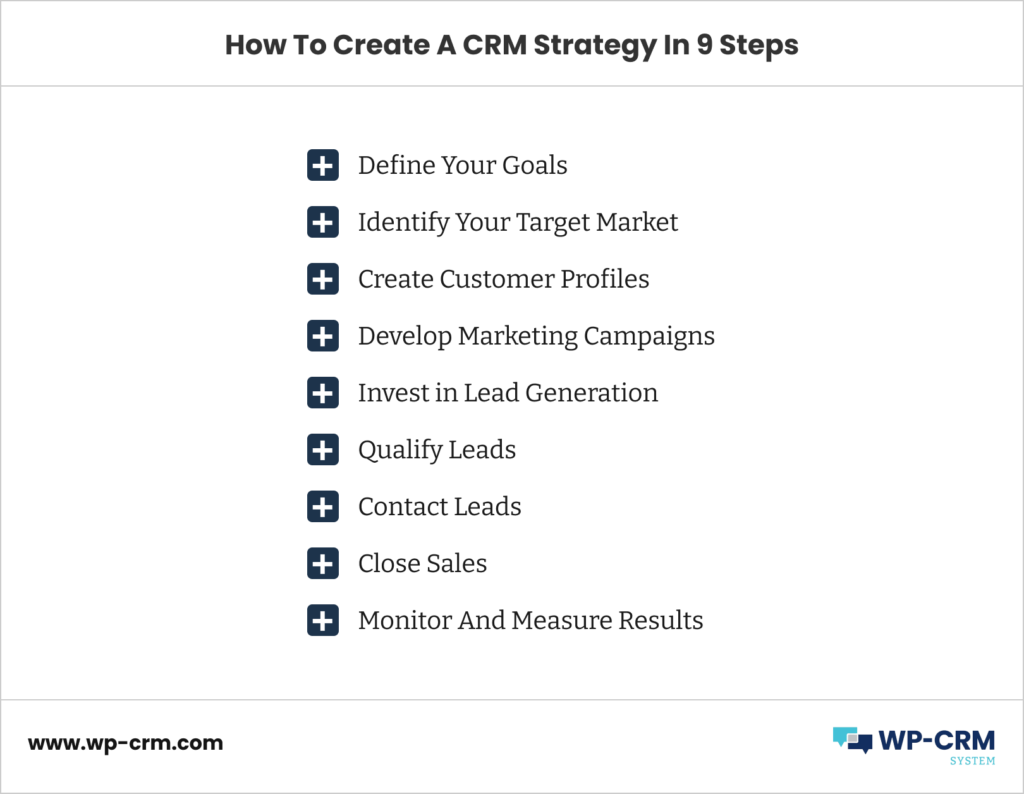9 Steps To Creating A CRM Strategy In 2023
As a business owner, it’s essential to have an effective CRM strategy in place. This is especially the case heading into 2023 – the year when customer service will be more important than ever before.
To help you stay ahead of the curve and create a CRM system that works for your needs, let’s take a look at 9 key steps you can follow to refine and maximize success with your approach. In this article, we’ll walk you through every aspect of creating a winning CRM strategy in 2023 that will help drive sales and unbeatable customer satisfaction.
What Is A CRM Strategy And Why Does It Matter?

CRM stands for Customer Relationship Management. It is a tool that collects all customer data in one interface where your team members can work with it in a transparent and timely manner.
Our very own WP-CRM allows you to handle customers and prospects communication from your WordPress dashboard. It is easy to operate and keep your focus while performing your regular tasks on your company site.
However, despite using a CRM system in their business operations, nearly 90% of businesses fail to scale it. The main reason is quite obvious – not having a clear goal for what outcome you want to get out of the tool, i.e lack of proper strategy.
A CRM strategy is a set of well-defined steps to enhance customer relationships and boost revenues and profits while minimizing costs. By taking a company-wide approach and putting your customers first at all times, you can make sure that your business keeps going in the right direction.
Many companies use their integrated CRM software for inspection and reporting rather than as a tool for increasing their sales. For example, they send out emails to customers and then they use the reporting system to check how many people have opened them. However, without a clear strategy, this approach won’t yield desired results as h focus needs to be on the result rather than the process.
How To Create A CRM Strategy In 9 Steps

As businesses are increasingly relying on technology to manage customer relationships and boost their sales, it is more important than ever for companies to have an effective CRM strategy in place. Here are 9 steps to create one successfully for the new year.
1. Define Your Goals
The first step in creating a CRM strategy is to define your goals. What do you hope to achieve by implementing a CRM system? Do you want to increase sales, improve customer satisfaction, or reduce costs? Once you have defined your goals, you can begin to create a plan to achieve them.
2. Identify Your Target Market
The next step is to identify your target market. Who are your ideal customers? What needs do they have that you can address with your products or services? Once you have identified your target market, you can begin to create customer profiles.
3. Create Customer Profiles
Customer profiles are detailed descriptions of your ideal customers. They should include information such as demographics, psychographics, and purchasing behavior. Creating customer profiles will help you better understand your target market and what they are looking for in a product or service.
4. Develop Marketing Campaigns
Once you have defined your goals and target market, you can begin to develop marketing campaigns that will reach them. Your marketing campaigns should be designed to generate leads that can be converted into customers. To do this, you will need to create attractive offers and develop effective messaging that resonates with your target market.
5. Invest in Lead Generation
Lead generation is the process of generating leads, or potential customers, who can be contacted and sold to. There are many ways to generate leads, such as through online advertising, social media, or direct mail campaigns. Once you have generated a list of leads, you will need to qualify them to determine if they are good fits for your products or services.
6. Qualify Leads
Lead qualification is the process of determining whether or not a lead is a good fit for your products or services. There are many factors to consider when qualifying a lead, such as budget, authority, need, and timeline. Once you have qualified a lead, you can contact them and attempt to sell them your product or service.
7. Contact Leads
The next step in the process is to contact the leads that you have qualified. This can be done through phone calls, emails, or face-to-face meetings. When contacting leads, it is important to be professional and courteous. You should also have a clear understanding of what you are selling and how it can benefit the lead.
8. Close Sales
At this stage, it’s time to close the sale with the lead. This involves negotiating terms and conditions and coming to an agreement on price. Once the sale is closed, it is important to follow up with the customer and ensure that they are satisfied with the product or service that they have purchased.
9. Monitor And Measure Results
The final step in creating a CRM strategy is to monitor and measure your results. This will help you identify any areas that need improvement and make adjustments to your strategy accordingly. However, it is important to remember that measuring success should not be the end goal. A successful CRM strategy should focus on creating a long-term relationship with customers that results in increased sales and customer satisfaction.
The Takeaway
A CRM strategy is essential for any business that wants to stay competitive in today’s market. By taking the time to create a CRM strategy, you can make sure that your business is able to target the right leads, generate more sales, and improve customer satisfaction. Use our 9-step guide to create your own CRM strategy and position your business for success in 2023 and beyond.
